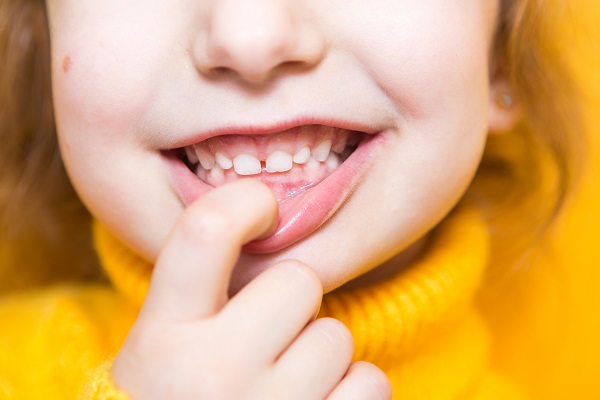When Your Child’s Baby Tooth Requires a Pediatric Dental Filling

Wondering whether a cavity on your child's baby tooth needs pediatric dental care? Read on to learn more. Even though baby teeth fall out naturally, these temporary teeth still play an important role in pediatric dental health. Baby teeth help ensure that permanent teeth grow in at the proper place and position. As a result, premature loss due to decay can lead to severely crooked adult teeth, as well as digestive and speech issues. For these reasons, cavities should be treated promptly in children of all ages.
Understanding the need for pediatric dental fillings
If tooth decay is discovered on a baby tooth during the early stages, other options may be explored first, along with careful monitoring. However, moderate to severe cavities will likely require a filling.
What is a pediatric dental filling?
A pediatric dental filling is one of the most common types of dental restorations for younger patients. The procedure is used to treat cavities (small holes on teeth). A dental filling involves cleaning the cavity of a tooth and filling it with a special material. The most common types of dental filling materials for kids are composite resin and amalgam, which provide an aesthetic quality as well as durable restoration.
The pediatric dental filling process
The process for a pediatric dental filling procedure may vary for each dentist. However, there are certain steps that can be expected. These steps include:
- Numbing the affected tooth (to ensure there is minimal discomfort)
- Cleaning and disinfecting the tooth
- Applying the filling material
- Hardening the filling material with a curing light
The process usually does not cause much, if any, discomfort. The procedure takes less than an hour in most cases. Nitrous oxide (also called “laughing gas”) may be recommended to help avoid any discomfort and to calm any nerves that are present.
The problem with childhood cavities
Tooth decay is incredibly common in young children. A variety of factors can put kids more at risk for getting a cavity, including:
- Thinner enamel on baby teeth
- A diet that is high in sugar
- The inability to brush and floss properly
- Exposure to high amounts of bacteria
While cavities may seem like a minor dental inconvenience, when left untreated, they can develop into serious problems. Infection and total tooth loss are possible when decay worsens over time. Therefore, most pediatric dental professionals recommend a filling as treatment if the cavity is significant or shows signs of growth.
Other treatment options for baby teeth
Even though a filling is the most common treatment for cavities in children, other alternatives may be used based on the child's needs and dental health history. Early intervention can delay or eliminate the need for fillings, while other options may be required if the decay is substantial.
Minor decay
If a cavity is small and minor, a pediatric dental professional will often recommend careful home care and close monitoring. Using fluoride toothpaste and adding fluoride mouthwash to a child's daily brushing routine may keep the decay from spreading. Limiting sweets and flossing carefully can also help. In some situations, a dentist may suggest an application of silver diamine fluoride, which kills harmful bacteria, strengthens tooth enamel and helps prevent further erosion.
Severe decay
Cavities that have been untreated for too long can weaken the overall structure of the affected tooth. When fillings alone will not be enough, a dental crown may be necessary. Typically, dentists use stainless steel crowns for children, as this option is more durable than porcelain. If the tooth cannot be saved, it will likely be extracted and a space maintainer will be placed in the empty spot. This small appliance helps keep the rest of the teeth in place until the permanent replacement grows in.
When to seek cavity treatment for your child’s baby teeth
Signs of a dental cavity should not be ignored. Ideally, weakened enamel is able to be treated before cavities form. Any time discoloration of enamel occurs, a visit to the pediatric dentist is strongly advised. It is also recommended to visit the dentist every four to six months for a routine cleaning and check-up.
A pediatric dental filling is often necessary for moderate to major cavities, even on baby teeth. Other alternatives exist for minor or severe tooth decay. Regardless of the recommended course of action, parents should have a child's cavities treated promptly to prevent serious complications.
Request an appointment here: https://www.grandparkwaypediatricdental.com or call Grand Parkway Pediatric Dental at (832) 222-8687 for an appointment in our Richmond office.
Check out what others are saying about our dental services on Yelp: Composite Fillings in Richmond, TX.
Recent Posts
Pediatric dentists often use tooth-colored composite fillings to repair cavities and damaged teeth. The combination of plastic resin and glass particles can last for years with proper care. They are a great option for those who want a natural-looking dental restoration for their children. This article will cover the process of recommending composite fillings for…
Cavities can happen to anyone, but they are especially prevalent in children. However, composite fillings restore their primary and secondary teeth without sacrificing appearance. Composite resin, or tooth-colored fillings, allows children to receive the necessary repairs without using unattractive metals that parents may remember from their childhoods. Many pediatric dentists now use this approach for…
If your child has cavities caused by tooth decay, composite fillings can fill the hole, protect their teeth, and restore their smile. Many parents prefer this option for their kids because it has a more natural appearance and does not create an eyesore. Others prefer them because they do not contain the same ingredients as…
Pediatric dental patients with chipped or broken teeth have more options for tooth repair than in the past, such as composite fillings. These dental fillings can both restore a tooth and prevent the increased chance of gaps in the smile or shifting teeth that usually follows a tooth extraction. They can also provide a natural-looking…


